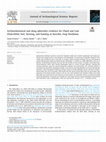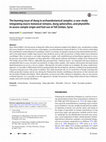Papers by Lucas Proctor
Kerkenes News/Kerkenes Haberleri, 2016
The biennial newsletter of the Kerkenes Project.
Kerkenes News/Kerkenes Haberleri, 2015
The biennial newsletter of the Kerkenes Project.

Archaeological and Anthropological Sciences, 2024
This study presents the results of a combined dendrological, macrobotanical, and dung spherulite ... more This study presents the results of a combined dendrological, macrobotanical, and dung spherulite analysis of flotation samples collected from Bronze Age, Late Assyrian, and post-Assyrian contexts at the site of Ziyaret Tepe, located on the southern bank of the Tigris River in southeastern Anatolia. The results of this study show shifting fuel resource exploitation between pre-urbanized phases of the site (ca. 3000–1600 BCE), the urbanized Late Assyrian occupation (882–611 BCE), and the ruralized post-Assyrian (ca. 611 BCE–1500 CE) re-occupations of the site. During the Late Assyrian period, Ziyaret Tepe is thought to have been the location of the city of Tušhan, an important provincial capital of the Neo-Assyrian empire. Evidence for local deforestation near the Tigris River and expanding reliance on dung fuel use during this period indicate overexploitation of fuel resources as larger populations and extractive imperial economic policies placed heavier pressure on local land use. Qualitative dendrological data provides evidence for the intensification of fuelwood harvesting during this period, while textual evidence documented an expansive program of timbering to the north of the site intended to fuel imperial construction projects in the Assyrian heartland. Following the abandonment of Tušhan and the collapse of the Neo-Assyrian empire, local fuel resource exploitation during subsequent occupations of the site shifted towards the direct management of wood fuel resources and increasing reliance on rural pastoralism.

Proceedings of the Seminar for Arabian Studies, 53, 2024
Analyses of archaeological fuel remains can provide insight into pyrotechnologies, resource manag... more Analyses of archaeological fuel remains can provide insight into pyrotechnologies, resource management, and the local environment. In this paper, we examine archaeological charcoals from Hafit period (3300-2700 BC) levels in Building V at al-Khashbah (al-Khashaba), Oman, to understand fuel harvesting and burning preferences associated with early copper production. Building V is currently thought to be the earliest identified copper-production site in Oman based on the presence of abundant pyrotechnological remains, copper slag, and stratified radiocarbon results. Here, we build on previous anthracological work reconstructing woodland composition from the site. Anthracologists are increasingly recognising that fuelwood collection is often based on social or functional grounds rather than species availability. To that end, we have combined traditional taxonomic analysis with the application of dendro-anthracological methods to examine how intensive wood harvesting was for copper production and whether it had effects on the local vegetation. Dendrological reconstruction of wood calibre and condition at burning combined with spatial patterning of remains provides a more nuanced view of these preferences than can be achieved through taxonomic analysis alone.

Journal of Archaeological Science: Reports, 2022
Agropastoral subsistence practices can provide important insight into economic organization and s... more Agropastoral subsistence practices can provide important insight into economic organization and surplus production, both integral factors in the emergence and development of socioeconomic inequality during the Chalcolithic Age of Southwest Asia. In this study, we examine evidence for plant husbandry, fuel use, and feasting in northern Mesopotamia during the Ubaid and Late Chalcolithic 1-2 periods (ca. 5200-3800 BCE) at the site of Surezha. Archaeobotanical remains from tell sites like Surezha are the product of multiple, interrelated depositional pathways, which, when carefully disentangled, speak to a variety of human behaviors, including fuel selection preferences, plant and animal management strategies, and commensality. The combined analysis of carbonized and mineralized carpological remains, wood charcoal, and dung spherulites recovered from Surezha document a mixed agropastoral subsistence strategy relying on animal husbandry and the cultivation of barley, hulled wheats, flax, and various pulses. Wild/weedy taxa and crop-processing debris made up a particularly large proportion of the preserved plant remains at the site, and, when combined with abundant evidence from dung spherulites and overall lack of wood charcoal, provide evidence for substantial reliance on dung fuel burning during the Chalcolithic. The dataset also includes one of the largest and most unique assemblages of mineralized seeds identified to date in Mesopotamia, which may represent the remnants of LC 1-2 feasting activities.

Journal of Archaeological Science: Reports, 2020
Excavations at the site of Qızqala in the Şərur Rayon of Azerbaijan’s Autonomous Republic of Naxç... more Excavations at the site of Qızqala in the Şərur Rayon of Azerbaijan’s Autonomous Republic of Naxçıvan have yielded evidence of a fortified settlement occupied from the Middle Bronze through the Early Iron Ages (2500–800 BCE), as well as a rich mortuary landscape of monumental kurgan burials dating to the Middle Bronze Age. This study describes the combined faunal and macrobotanical evidence for agropastoral production from the settlement at Qızqala and from animal offerings incorporated into nearby contemporaneous mortuary contexts. Such data provide a unique opportunity to elucidate the underlying subsistence system supporting the inhabitants at Qızqala, and to compare this system with the choices ancient people made when interring their dead in the nearby kurgans. While this dataset is modest, our goal is to integrate both plant and animal data stemming from different types of social practices in order to draw a more holistic view of agropastoral production and ritual practice during this period.

by Dorian Q Fuller, Lisa Janz, Maria Marta Sampietro, Philip I. Buckland, Agustín A Diez Castillo, Ciler Cilingiroglu, Gary Feinman, Peter Hiscock, Peter Hommel, Maureece Levin, Henrik B Lindskoug, Scott Macrae, John M. Marston, Alicia R Ventresca-Miller, Ayushi Nayak, Tanya M Peres, Lucas Proctor, Steve Renette, Gwen Robbins Schug, Peter Schmidt, Oula Seitsonen, Arkadiusz Sołtysiak, Robert Spengler, Sean Ulm, David Wright, and Muhammad Zahir Science, 2019
Environmentally transformative human use of land accelerated with the emergence of 5 agriculture,... more Environmentally transformative human use of land accelerated with the emergence of 5 agriculture, but the extent, trajectory, and implications of these early changes are not well understood. An empirical global assessment of land use from 10,000 BP to 1850 CE reveals a planet largely transformed by hunter-gatherers, farmers and pastoralists by 3,000 years ago, significantly earlier than land-use reconstructions commonly used by Earth scientists. Synthesis of knowledge contributed by over 250 archaeologists highlighted gaps in archaeological 10 expertise and data quality, which peaked at 2000 BP and in traditionally studied and wealthier regions. Archaeological reconstruction of global land-use history illuminates the deep roots of Earth's transformation through millennia of increasingly intensive land use, challenging the emerging Anthropocene paradigm that anthropogenic global environmental change is mostly recent. 15 One Sentence Summary: A map of synthesized archaeological knowledge on land use reveals a planet transformed by hunter-gatherers, farmers and pastoralists by 3,000 years ago.
Authors not found on Academia:
Torben Rick, Tim Denham, Jonathan Driver, Heather Thakar, Amber L. Johnson, R. Alan Covey, Jason Herrmann, Carrie Hritz, Catherine Kearns, Dan Lawrence, Michael Morrison, Robert J. Speakman, Martina L. Steffen, Keir M. Strickland, M. Cemre Ustunkaya, Jeremy Powell, Alexa Thornton.

Since Naomi Miller's first discussion of dung fuel within macro-botanical samples from Malyan, Ir... more Since Naomi Miller's first discussion of dung fuel within macro-botanical samples from Malyan, Iran, considerations of dung fuel across Southwest Asia have become commonplace, yes archaeobotanists remain divided on: (1) the extent to which dung fuel contributed to archaeobotanical assemblages relative to remnants of repeated crop processing and household activities; and (2) the plant-based, middle-range theories that should be used to infer the presence of dung within macro-botanical assemblages. Here we present a case-study integrating a simple, well-established geo-archaeological approach to assess the presence and relative abundance of dung spherulites within paired sediment and flotation samples from Ubaid period Tell Zeidan, Syria (5300–5100 bc). Spherulite data generated from " sediment smears " are integrated with macro-botanical and phytolith data to assess elevated concentrations of dung within samples. Our analyses demonstrate that plant-based depositional processes across a site are complex, reflecting the rich nature of plant use in antiquity. By using a multi-proxy approach, it is possible to differentiate between predominantly fuel-based deposits and those resulting from predominantly crop-processing processes with greater resolution. This study documents the use of wood fuels in hearths and dung fuel within pyrotechnic features and an oven during the Ubaid period, thereby contributing to discussions of fuel selection and the Secondary Products Revolution. When spherulites are preserved within sediment in abundance, they are also present in floated material, so it is possible to use this approach to consider the presence of dung within archived macro-botanical samples and resolve decade-old debates.

This article presents the results of excavations at Ziyaret Tepe, the Late Assyrian city of Tušha... more This article presents the results of excavations at Ziyaret Tepe, the Late Assyrian city of Tušhan in the Diyarbakır Province of southeastern Turkey during the summers of 2011-2013, as well as from a study season in 2014. Excavation in nine operations is briefly summarized, and the preliminary results of zooarchaeological and archaeobotanical studies in three operations are presented. Major public buildings of the Late Assyrian period (c. 882-611 BC) were recovered in Operation AN (palace), Operation W (administrative building), and Operation Y (city fortification), while an exposure of domestic architecture was revealed in Operation K. Also of importance from these field seasons was the documentation of a Late Roman, or Late Antique, occupation in Operations T and U. Zooarchaeological evidence from earlier excavations in Operation K reveal the subsistence practices of commoners during the Late Assyrian period. Likewise, the use of plants for human food and animal fodder are discussed for the Late Assyrian (Operation Q, the city gate excavated earlier) and the Late Antique (Operation T, domestic housing) periods. These combined reports outline the importance of animal husbandry, as well as agricultural production of grain, as key economic aspects of the Late Assyrian settlement, and complement existing cuneiform documentation.
This article considers the study of wood and dung fuel use in antiquity across Southwest Asia by ... more This article considers the study of wood and dung fuel use in antiquity across Southwest Asia by anthracologists and archaeobotanists. In recent years, the socially conditioned nature of fuel use has been highlighted and many scholars are stressing the central importance of fuel to pre-modern societies as on par with subsistence and tool use. By elevating and unifying the study of ancient fuel through anthracological, archaeobotanical, geochemical, and micromorphological studies, detailed insights into cultural practices, decision making, and resource use in the past can be gained. We provide a brief review of studies examining ancient fuel use and reflect on the integration of wood and seed data where seed assemblages are indicative of dung fuel use.
Excavation Reports by Lucas Proctor
Kerkenes 2015 sezonu çalışmaları Mayıs ayı başından Temmuz ayı başına kadar iki aydan biraz fazla... more Kerkenes 2015 sezonu çalışmaları Mayıs ayı başından Temmuz ayı başına kadar iki aydan biraz fazla bir süreyle gerçekleştirilmiştir. Çalışmaların ilkbaharda başlaması Kerkenes Projesi'nin simgesi haline gelen jeofiziksel yüzey
Book Chapters by Lucas Proctor
Kazı Sonuçları Toplantısı, 2023
Kerkenes Projesi'nin 2020-2021 sezonlarına raporu
The Archaeology of Anatolia, Volume III, 2019
Ayşegül Akın Aras is currently a Ph.D student in the Protohistory and Near Eastern Archaeology De... more Ayşegül Akın Aras is currently a Ph.D student in the Protohistory and Near Eastern Archaeology Department at the Social Science Institute. She has participated in two excavations and survey projects in Anatolia, including working at the Van Ayanis Castle excavations since 2012. Oğuz Aras is currently a Ph.D student in the Protohistory and Near Eastern Archaeology Department at the Social Science Institute. He has participated in many excavation and survey projects in eastern and southeastern Anatolia, including working at the Van Ayanis Castle excavations since 2011.
The Archaeology of Anatolia, Volume III. Recent Discoveries (2017-2018), 2019
The Archaeology of Anatolia Volume II: Recent Discoveries (2015-2016), 2017
2019-2020 Yılı Kazı Çalışmaralı, 2022
Kerkenes Projesi'nin 2019 sezonu raporu
Kazı Sonuçları Toplantısı, 2020
Kerkenes Projesi'nin 2018 sezonu raporu
Kazı Sonuçları Toplantısı, 2019
Kerkenes Projesi'nin 2017 sezonu raporu











Uploads
Papers by Lucas Proctor
Authors not found on Academia:
Torben Rick, Tim Denham, Jonathan Driver, Heather Thakar, Amber L. Johnson, R. Alan Covey, Jason Herrmann, Carrie Hritz, Catherine Kearns, Dan Lawrence, Michael Morrison, Robert J. Speakman, Martina L. Steffen, Keir M. Strickland, M. Cemre Ustunkaya, Jeremy Powell, Alexa Thornton.
Excavation Reports by Lucas Proctor
Book Chapters by Lucas Proctor
Authors not found on Academia:
Torben Rick, Tim Denham, Jonathan Driver, Heather Thakar, Amber L. Johnson, R. Alan Covey, Jason Herrmann, Carrie Hritz, Catherine Kearns, Dan Lawrence, Michael Morrison, Robert J. Speakman, Martina L. Steffen, Keir M. Strickland, M. Cemre Ustunkaya, Jeremy Powell, Alexa Thornton.
The site of Surezha, located 20 km south of the modern city of Erbil, is a 22-hectare conical mound with well-stratified deposits dating to the Chalcolithic Period, ca. 5300 to 3100 B.C., when the first urban societies began to emerge in Mesopotamia. Excavations have been conducted by the Oriental Institute since 2013 in order to investigate the emergence of social complexity and the origins of towns and later cities. This poster presents the results of a combined archaeobotanical, anthracological, and geoarchaeological analysis of two multiphase houses at Surezha, illustrating the kinds of fuel remains present within the hearths and refuse deposits of the structures, and the spatial distribution of fuel remains between houses and/or between different deposits. The results of this analysis suggest mixed fuel use across the site, with dung fuel and crop processing debris preferred within household hearths, while woody taxa were recovered from a large circular pyrotechnic feature in the west house. Wood fuel may therefore have been reserved for specialized craft production activities, while dung was used primarily for cooking and heating.